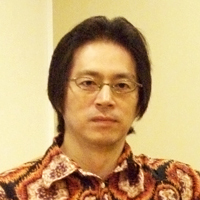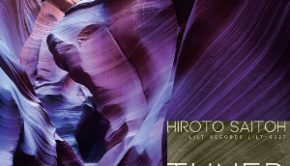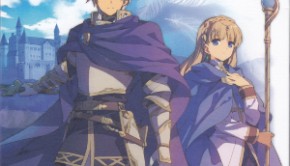Hiroto Saitoh Interview: Acquainting the West with a Veteran Composer
 Hiroto Saitoh is a versatile game music composer acclaimed for his works on titles such as Schwarzschild, POWER DoLLS, Technictix, Berwick Saga, and Folklore. After leaving developer Kogado Studio, he formed his own record label LILT Records and has gone on to publish several original albums and game soundtracks featuring his own work.
Hiroto Saitoh is a versatile game music composer acclaimed for his works on titles such as Schwarzschild, POWER DoLLS, Technictix, Berwick Saga, and Folklore. After leaving developer Kogado Studio, he formed his own record label LILT Records and has gone on to publish several original albums and game soundtracks featuring his own work.
In his first interview for an English audience, Hiroto Saitoh reflects on his career so far. He details his origins composing music for both Face and Kogado Studio, before detailing some of his most significant orchestral, electronic, and world music scores. He concludes the interview with a discussion of the history and principles of LILT Records and details the concepts of five of his original albums, including the newly released S-MODE.
Interview Credits
Interview Subject: Hiroto Saitoh
Interviewer: Don Kotowski, Chris Greening, Bryan Matheny
Editor: Chris Greening
Translation & Localisation: Christopher Ling, Ben Schweitzer
Coordination: Nima
Interview Content
Don: We are truly very grateful for your time, Hiroto Saitoh. First, could you introduce yourself and your musical career for the benefit of those who are not familiar with your work? What made you want to become a composer?
Hiroto Saitoh: When I was in high school, I admired Yellow Magic Orchestra (YMO), so I bought a synthesizer and started a cover band, and that was the beginning of everything. At that time, I put all of my effort into the band instead of studying (laughs). Besides YMO I played keyboard in hard rock bands, fusion bands, and so forth whenever I had the opportunity. I continued doing so, and when I was in my final year of high school, I seriously began to consider music as a profession.
For a year after I graduated, I played with the band, wandering around Tokyo’s venues. The next year I entered a music school, and I spent five years until graduation studying how to compose classical music. I was an active member of a group that composed modern-style classical music, but on the other hand, I loved video games, and I gradually became fascinated by the unique world of game music, so I came to think that I might want to try writing it myself.

Don: Your first major projects as a composer were for Kogado Studio. Please tell us about your role there and the music you composed. What are the most significant works that you created there?
Hiroto Saitoh: Actually, before Kogado Studio, I headed a few projects at Face for the PC-Engine, namely Metal Stalker, Metal Combat Police, etc. After that I left the company, and entered Kogado Studio to compose game soundtracks for them. I only knew a little bit of C and Assembler, so when I entered the company I asked some of the planners and graphic designers to create a conversion tool for me. Incidentally, on Super Schwarzschild 2 I compiled about half of the script programming for the movie scenes, so my name is also under graphics in the end credits (laughs).
The main projects I participated in were:
PC-9801
Schwarzschild III & IV
The entire “POWER DoLLS” series
The entire Sequence Palladium series
The entire “Rasetsu” series
PC-Engine CD-ROM2
Super Schwarzschild 2
The entire “Louga” series
There are a lot of projects that I participated in part-way through development around the time I entered the company. Because Louga was the first project in which I participated as main composer, it has made a lasting impression on me.
Don: The aforementioned Schwarzschild series was one of your early projects. Please tell us about your experiences composing for the series. Was it difficult to compose using a technologically limited computer?
Hiroto Saitoh: The first game in the series I participated in was the NEC PC-9801 game Schwarzschild III. I only composed two tracks for the game as I came in part-way though development. At that time the music for computer games was not recorded live the way it usually is now. It was primarily played on the external FM sound driver. The FM sound driver that we used at Kogado Studio back then could play no more than three notes at a time, so the first channel had to be used for melody, the second for counter melodies and such, and the third channel had to alternate between the bass and the rhythm, doing the work of two instruments.
These limitations were extremely restrictive, so from Schwarzschild IV on, we got a new sound driver, so I could use three channels of FM synth and three channels of PSG. But even though the number of voices had doubled, it still wasn’t enough to express what I imagined, and I had to be very careful to choose harmonies that approached my ideal conceptions.

Don: The POWER DoLLS series is probably your most famous work at Kogado Studio. Please tell us about your overall direction and how you composed the themes of the project. How did the series’ music develop as computers evolved technologically?
Hiroto Saitoh: From the first meeting, I heard that the director had established that POWER DoLLS’ “main characters are women soldiers, active on the battlefield,” so I knew that this was a different kind of project from other strategy games. So it was a huge challenge for me to create music for this new world. It was a good opportunity, so I figured I would write music in a different genre from what I had done for other Kogado projects. After some trial and error, I thought of writing acid jazz.
Until the third POWER DoLLS game, Advanced POWER DoLLS, we supported only FM synth and GS MIDI, but from the fourth we switched to CD-DA. Although the quality of the sounds improved when we switched, the actual music didn’t change very much.
Don: Recently, a POWER DoLLS 1 arrange soundtrack called POWER DoLLS 1 Soundtrack Resonance was released, coinciding with a remake of the game. What was your inspiration for the album? Do you have any plans to arrange any of the other POWER DoLLS soundtracks?
Hiroto Saitoh: 14 years had passed since the release of the first POWER DoLLS soundtrack, and in that time, my production environment had changed greatly, as had my sound. So I thought it would be very interesting to rearrange the old POWER DoLLS music. Instead of doing all of the work myself, I invited guest arrangers so that the style would be newer. I let the arrangers play to their strengths and arrange freely outside of the confines of “game music.” Because of that, we were able to create a new album, different and fresh. There aren’t any plans for successors, but it would be nice to create albums based on the rest of the series.
Don: Speaking of arrangements, you participated in several Supersweep arranged albums, such as the Technictix Remix series. Please tell us about your work on the Technictix and Technic Beatsoundtracks, then let us know about how you approached the arrangements for the Technictix Remix series.
Hiroto Saitoh: I wrote music for both games, which were on the PlayStation 2 (Technic Beat also had an Arcade version). The data used in the game had to be divided up so as to respond to the player’s input, I also intentionally made the volume of the sounds responding to the players’ button presses loud so that they would notice. On the soundtrack, though, I had to hold back and preserve a balance so that it would be easier to listen to. If I were to simply arrange my own pieces, it would probably have just been rehashing past work, so I purposefully arranged other people’s music.

Don: Berwick Saga was one of your first orchestral scores. How did you adjust to this different style while retaining your emotionally appealing multigenre approach?
Hiroto Saitoh: Actually, my first orchestral score was for the PC-Engine’s Super Schwarzschild 2; it seems like you weren’t informed. (laughs)
If one tries too much to imitate the great works of the past, it will become humiliating, and the music created will not be any good, so I figure that since I am the one composing I should let the music be my own. There is a feeling of power in that. At the first meeting for Berwick Saga, the producers told me “the truth is, we already have this kind of music integrated,” and played some pieces for me. Unexpectedly, the music was different from anything else in the series. When I heard that, I understood that the producer was seeking a new sound, and I felt less tense. I didn’t strain too much, and accomplished the work myself. By the way, the track “War Clouds” from the Berwick Sagasoundtrack is the one closest to their request.
Don: Folklore had a powerful orchestral soundtrack by you, Kenji Kawai, Ayako Saso, and Shinji Hosoe. How did you get involved with the project? Unlike Berwick Saga, your compositions in Folklore were action themes. What was your particular inspiration for these various themes, particularly “Collapse”?
Hiroto Saitoh: The sound of Folklore was closer to movie music than game music. So we stayed away from writing melodies that directly appeal to emotion, and stuck to emphasizing atmosphere instead. “Collapse” is the final battle music in the other world. My client had requested that it not be normal — that it have a feeling of madness — so I composed using rhythms and scales from modern art music.
Don: Cross Hermit is another popular work using ethnic styles from various countries. Would you explain to us your insights about the music in the game in more detail?
Hiroto Saitoh: Cross Hermit frequently uses ethnic melodies and tone colors. The world view of medieval Europe was used as a foundation, but it is an imaginary world, so it doesn’t represent any specific country, and the essences of the ethnic musical styles of the Middle East, Northern Europe, and Asia were added. I do not think there is any particular way in which I want listeners to listen to the music. It has become a product; that is to say, the music has left the hands of its creator. If you like the music, then it is best to play the game.

Don: Unlike Cross Hermit, Ayashi no Miya and Usotsuki to Inugamitsuki feature traditional Japanese style music and modern styles, especially Jazz and Electronica. What were your inspirations for these two projects’ overall directions? Was there a particularly difficult point in the composition of these two soundtracks? Are there any themes that left an impression on you?
Hiroto Saitoh: Although they both have a Japanese feel, Ayashi no Miya is set in ancient Japan, andUsotsuki to Inugamitsuki in the modern world, with computers and cell phones, so the eras are entirely different. So in Usotsuki to Inugamitsuki, I actively used synth and club-like beats, and on the other hand, I emphasized elements of Japanese traditional music at pivotal points in Ayashi no Miya.
The hard part was writing the approximately 10 pieces of theme music for the playable characters, and making sure that they differentiated the characters. It was quite a challenge to write character themes that didn’t resemble each other. The title music for Ayashi no Miya and the theme for Inuhiko in Usotsuki to Inugamitsuki both left strong impressions.
Don: Many of your works are brought out by LILT Records. Can you explain the history and creation of the company?
Hiroto Saitoh: When I became independant from Kogado, I created Lilt Records because I wanted to have a way to release my original music. (It’s not an organization, but on the individual level only.) I didn’t really have any plans for the future, but I felt that it was most important that the budget, allotted time, and the albums’ musical content be entirely my responsibility. That is, if there are enough people who want a soundtrack, I’ll release it, disregarding profits. With the Cross Hermitsoundtrack, for example, I had the maker’s cooperation in releasing it myself.
Don: You’ve composed a number of original albums, such as WORLDNAUT, Dia Novo, and Melodia. Could you discuss how you marketed these albums through Comiket events and record labels such as SuperSweep? Do you think these works were sucesses?
Hiroto Saitoh: I met Shinji Hosoe-san, Ayako Saso-san, and the rest of SuperSweep at the first event I participated in, M3, right after I set up my own label. It was a coincidence, but it ended up leading to a long relationship. I like events because interesting meetings like that happen. Instead on simply selling CDs normally, I participate four times every year in Comiket and M3, selling directly. I do not simply aim to sell CDs; I can hand over the CDs directly and express my gratitude to the listeners. Sometimes I have conversations with the customers, and I believe it is important to have the opportunity to connect directly with people in this way. I take care to remember that I am what I am now because I have listeners.
Although it is hard to discern what has been “a success,” certainly, there are more people who listen to my music, so that means there has been a result, I suppose. I would be happy if, after this, more people were to listen to my CDs overseas.

Don: Regarding your original music, please could you discuss the concept and content of the following albums:
Hiroto Saitoh: Including the mini albums, the list of everything I’ve released would be too long, so I’ll confine this list to an introduction of the most important ones:
WORLDNAUT: This was the first work I released after creating the label. I created whatever came to mind that I liked. I recorded House, Techno, Jazz, Latin, and vocal pieces; I think that the vocal pieces are particularly individual. I wonder if there is anyone else who writes that kind of music?
Dia Novo: I selected some famous Bossa Nova pieces that I liked, and arranged them into various styles such as technopop.
Melodia: This was next album I created after Dia Novo. It was mainly written in a Jazz style, but I also tried my hand at writing music related to the Andes and China.
Vocalize: This was an original album sung by the Vocaloid program’s Hatsune Miku. I didn’t pay special attention to its being “Vocaloid music,” and simply created songs I wanted to create. That said, I created pieces in various styles: Heavy metal, Northern European, Techno, Acoustic, Spy movie-style, etc.
S-MODE: This is my most recent album, having come out in May of this year. Although I had originally planned that the entire album would be techno, I changed my mind part way through and mixed in a number of styles. (laughs) I detail the styles below:
1. Night Breeze (Soul)
2. Hard Beat (remix) (Hard Techno)
3. Blue Moon Rise (Electronica)
4. Toys on his Hands (Technopop)
5. Jazzpanese (Jazz/Lounge)
6. Vermillion View (Fusion)
Don: Let’s finish off the discussion of your record company by talking about your favorite works. Which of the works you composed are you most proud of? Which original album do you like the best of those you composed?
Hiroto Saitoh: Of course, I have the best memories of my first production, WORLDNAUT. The title comes from the merging of the words “WORLD” and “ASTRONAUT” into a new word. I want to freely swim around in the vast universe of music, I want to create music not confined by any restraints. The title conveys those desires. Although I created the album thinking that, I feel it is the album in which I most expressed my own musical personality, and I particularly like it.

Don: From all of us, we would like to thank you again for taking the time to do this interview. What are your future plans for yourself and your label? Do you have a message for your fans around the world?
Hiroto Saitoh: I am very glad that so many people from overseas are interested in listening to Japanese game music. Until now it has been mainly inside the country, so I will be preparing ways for people overseas to be able to listen to my music more easily. Thank you very much.
Many thanks to Game Music Net’s Don Kotowski and Lilt Records’ Nima for organising this interview. Thanks to Christopher Ling for translating the questions, Ben Schweitzer for translating the answers, and Bryan Matheny for additional support. All album images are copyright of LILT Records.
Posted on June 29, 2010 by Don Kotowski. Last modified on March 6, 2014.














